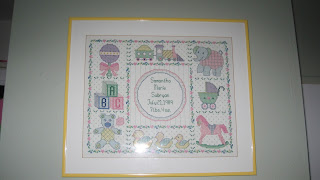For this week’s blog I didn’t want to choose a word to go “with scissors” that was cliché or typical in any way. I wanted to think of something that I have done that is creative and original and I finally came up with something. What I have chosen is “cross stitch” or also known as needlepoint. To some people this may not seem like art of any kind but I take great pride in the cross stitches that I have completed as they take a great deal of time and patience. They can be very personal as I have made many as gifts for family and friends and I also have on that was made for my from my mothers, a birth announcement.
 |
| My birth announcement made by my mother. |
Materials Needed:
- Cross stitch fabric
- Thread
- Cross stitch pattern
- Scissors
- Needle
Steps for Cross Stitch:
#1: Choose colour of threat that you wish to start using.
#2: Look at pattern and match appropriate symbols for that particular colour to where the symbol is on the pattern.
#3: Feed thread onto needle
#4: Create “X” in each square on fabric for each square required for that particular colour.
#5: Continue to create the “X’s” for that colour according to the pattern.
#6: Repeat steps 1-5 for every colour required until cross stitch is complete.
The art word for this week is design/composition, which is, in this textbook described as “anything and everything young children create in art” (Schirrmacher & Fox, 2009, p. 142). Design and composition in art attempt to meet such requirements as compiling line, shape, colours texture and form as a whole and having the finished product impart sense of overall order, coherence, equilibrium and organization (Schirrmacher & Fox, 2009, p. 142). To me, design is important when looking at a cross stitch and they definitely meet all those aspects as there is order and equilibrium (with a pattern) but also line, shape and colour, with the thread and also the pattern for the finished design. The design is the essence of the cross stitch because of how it looks like and the way it is put together is what you’re trying to achieve.
Doing cross stitches is definitely something that I take pride in and that I really enjoy doing. I really do not involve myself with arts & crafts very much but completing a cross stitch is something I love to do. My mother introduced me to them when I was a young girl, probably in elementary school. I started out with small patterns. I remember my mom teaching me how to do them and when I completed one and showed her, she was so proud and gave me wonderful compliments. I gradually became more confident doing them and eventually started making them as gifts for people.
I will always have a love for doing them. I definitely love putting the time it takes to complete them and then seeing the reactions of the people I give them to as gifts, how happy and appreciative they are. I always feel proud and accomplished, even if I have made one for myself. Like I said earlier, completing art projects is not really something that describes me but I feel this piece of art is something that describes me and that I am confident in doing successfully.
Schirrmacher, R., & Fox, J. E. (2009). Art & Creative Development for Young Children. Clifton Park, NY: Thomson Delmar Learning.








